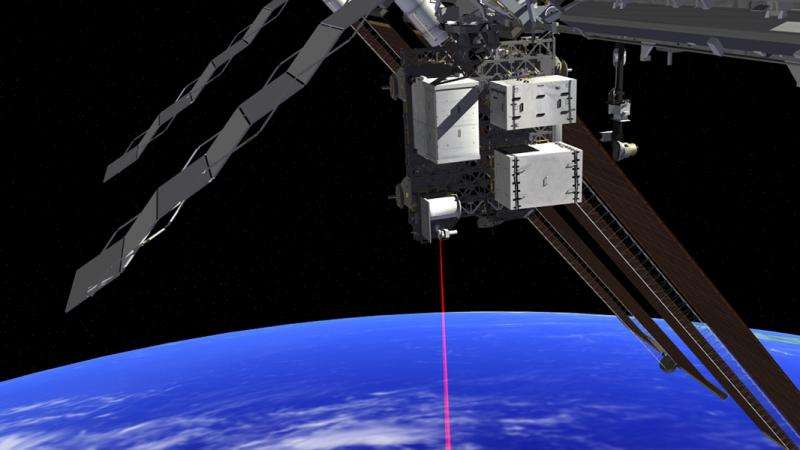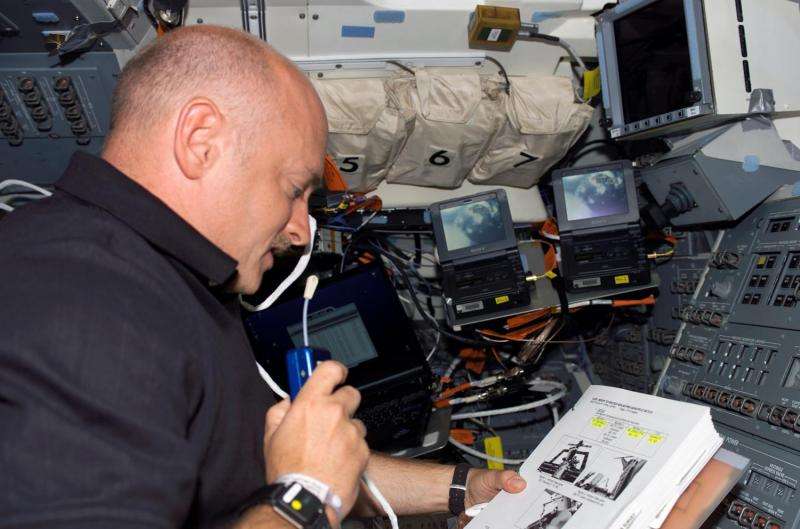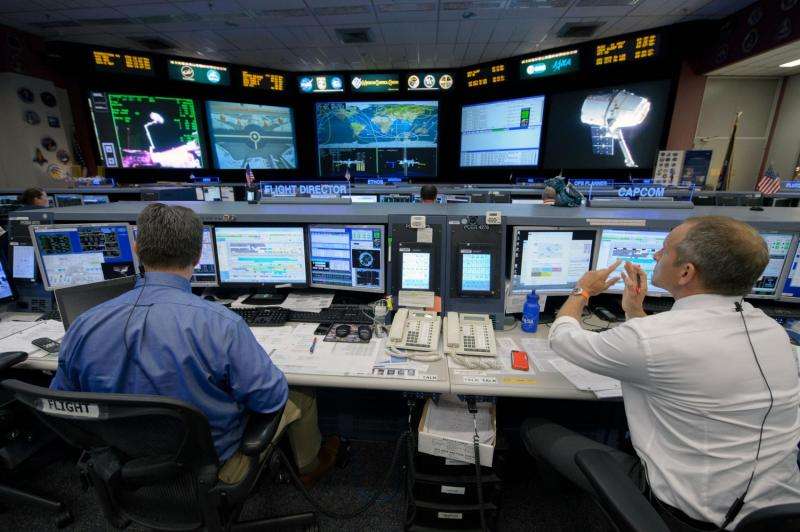This artist's concept shows how the Optical Payload for Lasercomm Science (OPALS) laser beams data to Earth from the International Space Station. Credit: NASA
Today's technology has all but eliminated time delays in telecommunication on Earth, but when they do occur they can be frustrating, especially when trying to communicate complex or time sensitive information. The same type of delay could happen when communicating with spacecraft and crew members in deep space on the journey to Mars. For example, communication over radio waves could have round-trip delays of up to 31 minutes at Mars. According to a recent investigation, this could impact team performance and emotional well-being.
Researchers for the Comm Delay Assessment investigation set out to determine whether communication delays, like those astronauts could experience on a long-duration mission to an asteroid or to Mars, will result in impacts to individual and crew performance and well-being. They did this by studying three crew members aboard the International Space Station and their mission control support teams completing 10 tasks during a recent increment: six tasks with no communication delay and four tasks with a 50-second delay. The tasks were based on two dimensions: novelty (how new the task was to each crew member) and criticality (how complex the task was for the crew member).
By analyzing pre- and post-flight interviews, video recordings and questionnaires, investigators were able to determine that high-quality communication (no delay) resulted in high performance and mood. Mood then decreased during tasks that included a delay.
"Crew members reported getting frustrated when they needed communication quickly," said Principal Investigator Larry Palinkas, Ph.D. "Tasks took longer and there was frustration when the crew members or Mission Control had to ask additional questions, because they were not getting the information they needed in a timely fashion, or there was miscommunication that needed clarification."
They also attributed some of the frustration to other distractions, including ambient noise in various locations in the space station, having "space brain" which makes things harder to remember and comprehend, and other crew members asking questions when another was trying to communicate with the ground.
STS-121 Pilot Mark Kelly, talks with mission control as he reads a checklist on the aft flight deck (AFD) of the orbiter. Communication delays between Mission Control and crew members during the Comm Delay Assessment that took place during a recent International Space Station increment posed challenges for crew members. Credit: Mark Kelly
According to Palinkas, crew members expressed that being understood by others was the most important aspect of the communication quality. Being understood by others was also significantly associated with perceptions of autonomy - whether the crew members had the opportunity to exercise independence. The autonomy boosted performance and moods during the tasks.
This autonomy also created more interaction among crew members. However, one crew member reported that, to some extent, this had a negative impact because they treat ground control as coworkers and collaborators and sometimes friends, so those relationships were impacted.
"We learned a lot from interviews with the crew members," added Palinkas. "They provided us with what personal aspects they felt were associated with the delay and provided suggestions for improving communication with the ground, especially related to long duration missions."
Some suggestions included asking longer and more detailed questions or conferring among themselves about what they need to ask ground control and how they should ask it, anticipating follow-up questions in advance. They also suggested incorporating communication delays in their training.
Other suggestions related to technology included using devices that could playback communications, supplementing communication with video, so ground control could have better context for questions, and developing communications technology that could reduce the delays.
Expedition 43 Flight Director Gary Horlacher (left) and Capcom David Saint-Jacques (right) in Mission Control Houston are at the Johnson Space Center during the release of the SpaceX Dragon cargo vehicle. CAPCOM personnel communicate regularly with crew members and participated in the investigation. Credit: NASA
One such technology was studied during the Optical Payload for Lasercomm Science (OPALS) investigation, which proved that using laser communications rather than radio waves allows you to transmit more data at faster speeds. In June 2014, NASA successfully beamed high-definition video via laser from space to ground at 50 megabits per second. (For reference, video streaming at 20 megabits per second is similar to watching live television.) The 175-megabit video was the first of its kind for OPALS and was the first step in improving the way we receive data from orbit and beyond. The focused laser energy offers the promise to achieve data rates 10 to 100 times higher than present-day space communications, which currently is similar to communicating via dial-up Internet service. OPALS' success is an important step in improving communication rates with spacecraft beyond low-Earth orbit.
"Optical comm could improve upon the delay," said OPALS Principal Investigator Abhijit Biswas, Ph.D. "It can certainly help with the capacity problem by bursting down huge volumes of data that could include voice and streaming video."
"The limited bandwidth of today's communication technology leads to the same frustration one experiences while waiting for a movie to buffer," says Bogdan Oaida, OPALS project systems engineer. "With optical comm, you wouldn't have that limitation."
In the meantime, OPALS continues to be a laser sensation. In March 2015, OPALS demonstrated that laser signals from the space station can be focused into fibers one-quarter the width of a human hair, which is the standard in the telecommunications industry. Later this year, researchers hope to use OPALS to help measure platform vibration on the space station, which could provide data that will assist with space station guidance and navigation. The research team will also work with several International Partners to attempt laser transmissions to ground stations in their respective countries. Technology such as OPALS along with additional methods for improving communication between Earth and deep space will provide crew members with the ability to "phone home" on their journeys to Mars and beyond while maintaining performance and morale.
Provided by NASA


























